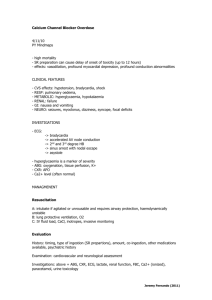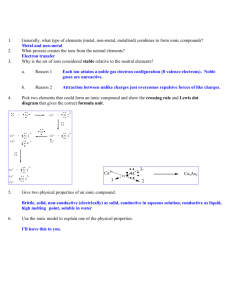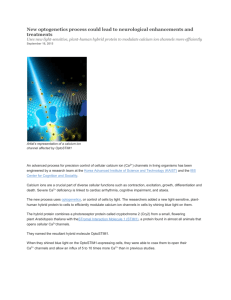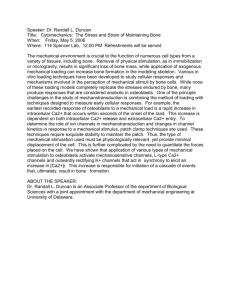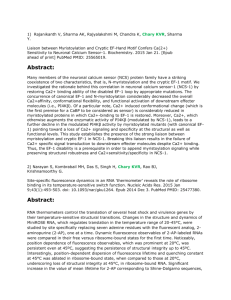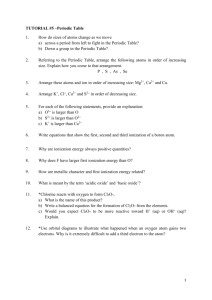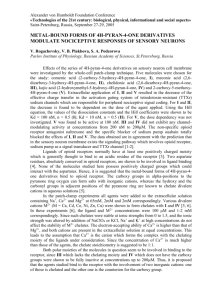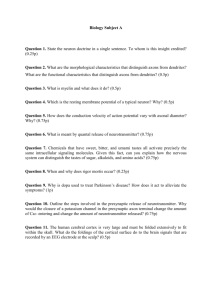Supplementary Notes - Word file
advertisement
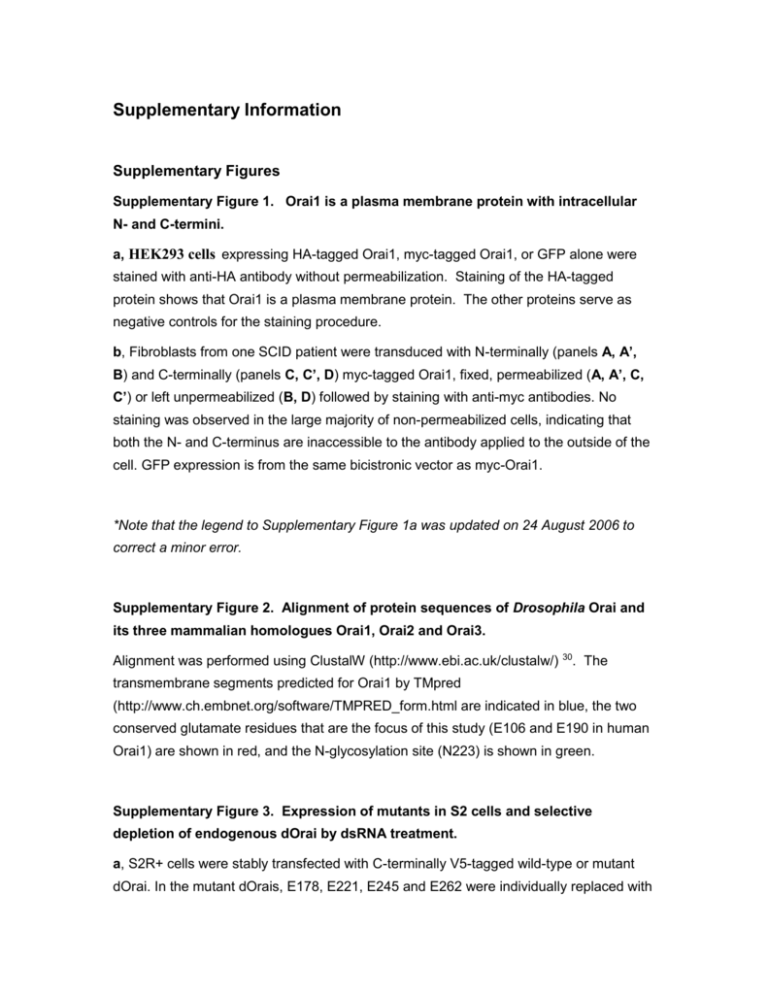
Supplementary Information Supplementary Figures Supplementary Figure 1. Orai1 is a plasma membrane protein with intracellular N- and C-termini. a, HEK293 cells expressing HA-tagged Orai1, myc-tagged Orai1, or GFP alone were stained with anti-HA antibody without permeabilization. Staining of the HA-tagged protein shows that Orai1 is a plasma membrane protein. The other proteins serve as negative controls for the staining procedure. b, Fibroblasts from one SCID patient were transduced with N-terminally (panels A, A’, B) and C-terminally (panels C, C’, D) myc-tagged Orai1, fixed, permeabilized (A, A’, C, C’) or left unpermeabilized (B, D) followed by staining with anti-myc antibodies. No staining was observed in the large majority of non-permeabilized cells, indicating that both the N- and C-terminus are inaccessible to the antibody applied to the outside of the cell. GFP expression is from the same bicistronic vector as myc-Orai1. *Note that the legend to Supplementary Figure 1a was updated on 24 August 2006 to correct a minor error. Supplementary Figure 2. Alignment of protein sequences of Drosophila Orai and its three mammalian homologues Orai1, Orai2 and Orai3. Alignment was performed using ClustalW (http://www.ebi.ac.uk/clustalw/) 30 . The transmembrane segments predicted for Orai1 by TMpred (http://www.ch.embnet.org/software/TMPRED_form.html are indicated in blue, the two conserved glutamate residues that are the focus of this study (E106 and E190 in human Orai1) are shown in red, and the N-glycosylation site (N223) is shown in green. Supplementary Figure 3. Expression of mutants in S2 cells and selective depletion of endogenous dOrai by dsRNA treatment. a, S2R+ cells were stably transfected with C-terminally V5-tagged wild-type or mutant dOrai. In the mutant dOrais, E178, E221, E245 and E262 were individually replaced with glutamine, respectively. Expression levels were evaluated by immunoblotting with antibody to the V5 tag. b, RNAi against the 3’-UTR of endogenous dOrai does not significantly affect expression of ectopically expressed dOrai lacking the 3’-UTR. S2R+ cells stably transfected with Cterminally V5-tagged wild-type dOrai lacking the 3’-UTR were incubated with the indicated dsRNAs. The V5-tagged recombinant protein was detected by immunoblotting with antibody to the V5 tag. Depletion of V5-tagged dOrai is accomplished by dsRNA against the coding region of dOrai (Orai), but not by dsRNAs against the 3’-UTR (UTR) or an irrelevant control sequence (GFP). Supplementary Figure 4. Evolutionarily conserved E106 in Orai1 is required for Orai1-mediated Ca2+ influx. a, Ca2+ influx-deficient fibroblasts from the SCID patients were stably transduced with a panel of myc-tagged Orai1 mutants in which glutamates (E) at positions 106 and 190 were individually replaced with alanine (E106A, E190A), glutamine (E106Q) or aspartate (E106D). Ca2+ influx was compared in GFP+ (Orai1-expressing) cells in response to perfusion with 20 mM extracellular Ca2+ following store-depletion with 1 M thapsigargin (TG). Left panels: Mutant E106A did not restore Ca2+ influx in the SCID cells whereas a partial restoration was observed with the E106D and E106Q mutants. Mutant E190A reconstituted normal peak Ca2+ levels. Right panels: Residual Ca2+ influx in the E106D, E106Q and E190A mutants was sensitive to inhibition by 2 M La3+. A moderate potentiation of Ca2+ influx with low doses of 2-APB (2 M) was seen in the E190A mutant but not in the unresponsive E106A mutant. b, Summary of peak Ca2+ responses (top panel) and initial rates of Ca2+ influx (bottom panel) from experiments similar to those shown in a. Averages are from two to five independent experiments per mutant. Supplementary Figure 5. Orai1 mutant proteins are expressed in the plasma membrane. HEK293 cells were transfected with mutant forms of Orai1 containing an HA-tag in the predicted second extracellular loop. Cells were left unpermeabilized, fixed, and stained on ice with anti-HA antibodies. GFP expression is from an IRES-site in the same expression vector. Note that all mutants of Orai1 are expressed in the plasma membrane and show staining that is comparable to the staining of wild-type Orai1 (see Fig. 1). Supplementary Figure 6. Ca2+ influx in SCID T cells expressing glutamate mutants of Orai1 is sensitive to inhibition by La3+. T cells from CRAC-deficient SCID patients were stably transduced with myc-tagged wildtype Orai1 or Orai1 mutants in which glutamates (E) in positions 106 and 190 were individually replaced with alanine (E>A), glutamine (E>Q) or aspartate (E>D). Ca2+ influx was compared in GFP+ (Orai1-expressing) cells following store depletion with 3+ shortly after the peak of the Ca2+ response in 2 mM Ca2+. Experiments shown are representative of at least three similar experiments. Supplementary Figure 7. Leak-corrected current in control cells is negligible. I-V curves obtained after leak correction with La3+ from an untransfected SCID T cell (GFP-) taken from one of the same experiments in which GFP-positive cells showed reconstitution of CRAC current, and from a SCID T cell expressing a nonfunctional mutant Orai1 (R91W). The lack of evident inward or outward current in these cells validates the conclusion that the leak-corrected currents in cells expressing E106D, E190D, and E190Q Orai1 proteins represent altered CRAC channel currents. Supplementary Figure 8. Concentration dependence of the block of monovalent ion current by Ca2+. A further representative experiment illustrating the concentration dependence of Na+ICRAC block by extracellular Ca2+ in cells expressing E106D Orai1. Standard Ringer solution containing 20 mM Ca2+ was replaced by solutions with [Ca2+]o as indicated. DVF indicates divalent ion-free solution. Supplementary Methods Cell lines. Human T cell lines from one control individual and SCID patient 2 were immortalized by transformation with herpes virus saimiri (HVS) as described 31. Foreskin fibroblasts from the newborn SCID patient 2 and a healthy newborn (Hs27 cell line, ATCC, Manassas, VA) were immortalized by retroviral transduction with a telomerase expression plasmid (hTERT, S. Lessnick, DFCI, Boston, MA). T cells and fibroblasts were grown as described 32. The macrophage-hemocyte-like Drosophila cell line S2R+ was grown in Schneider’s medium with 10% fetal calf serum (Invitrogen) according to standard protocols. Plasmids, retro- and lentiviral transductions. Full-length cDNA for Orai1 (BC015369) was purchased from OpenBiosystems (Huntsville, AL) and subcloned into pENTR11 (“Gateway” system, Invitrogen, Carlsbad, CA) for use in retroviral transductions. For all myc-epitope tagged vectors, the c-myc sequence (peptide: MEQKLISEEDL; nucleotide: ATG GAA CAA AAA CTT ATT TCT GAA GAA GAT CTG) was placed in frame immediately in front of (N-terminal myc-tag) or behind (C-terminal myc-tag) the coding sequence of Orai1. In case of the N-terminal myc-tag, the transcription start site (ATG) was placed at the beginning of the myc sequence deleting the endogenous start codon; in case of the C-terminal myc-tag, the endogenous stop codon was replaced with GAG encoding the first E of the myc-tag; at the end of the myc sequence a TAG codon was added to terminate translation. For mutagenesis of Orai1, a standard 2-step PCR approach with pairs of overlapping degenerate primers spanning the mutation site was used. Tagged Orai1 cDNA was then transferred from pENTR11 to the bicistronic retroviral expression vector pMSCV-CITE-eGFP-PGK-Puro (M. Ohora, CBRI, Boston), which allows for simultaneous expression of Orai1, GFP and a puromycin resistance gene. C-terminally FLAG-tagged Orai1 was subcloned into XhoI-EcoRI site of pMSCVCITE-eGFP-PGK-Puro. The endogenous termination codon was substituted with the FLAG-tag coding sequence (AADYKDDDDK) followed by a TAG termination codon. For mutation of the N-glycosylation site (N223) in Orai1, AAC (Asn) was replaced with GCC (Ala). For lentiviral transduction, N-terminally myc-tagged versions of Orai1 were directly cloned NotI-BamHI into the bicistronic pHAGE-UBC-eGFP-IRES-eGFP vector (R. Mulligan, Harvard Medical School), replacing the first eGFP with myc-Orai1. For the introduction of an HA-tag into the second extracellular loop of Orai1, an XbaI-XhoI site was introduced between amino acid positions 207 and 208 or 214 and 217 (in the latter case deleting amino acids 215 and 216) followed by ligation of a double-stranded oligonucleotide encoding the HA peptide flanked by a glycine-serine-glycine-serine linker on either side (5’ CT AGA GGA AGC GGA AGC TAT CCA TAT GAC GTC CCA GAC TAT GCC GGA AGC GGA AGC C; 3’ TC GAG GCT TCC GCT TCC GGC ATA GTC TGG GAC GTC ATA TGG ATA GCT TCC GCT TCC T). For retroviral transductions, HEK293FT (Invitrogen) cells were co-transfected with plasmids encoding Orai proteins, gag-pol and env to produce amphotropic, replication-incompetent retrovirus; virus-containing supernatant was collected 1, 2 and 3d after transfection and or lentiviral transductions, HEK293FT cells were co-transfected with plasmids encoding Orai proteins, gag-pol, rev, tat and VSVG proteins, virus was collected 1, 2 and 3d after transfection, filtered and concentrated by centrifugation at 40,000 x g for 3h. Transduction efficiencies were evaluated by GFP expression using flow cytometry and myc-Orai1 expression using immunoblotting and immunocytochemistry. Western blots, immunoprecipitation and surface biotinylation. HEK293 cells were stably or transiently transfected with mammalian expression vectors. In transient expression studies, cells were harvested in Triton lysis buffer (1.0 % TritonX100, 20 mM Tris pH 7.4, 150 mM NaCl, 1 mM EDTA, 20 mM -glycerol-phosphate, 10 mM sodium pyrophosphate, 0.1 mM sodium orthovanadate, 10 mM NaF, 1 mM phenylmethylsulfonyl fluoride (PMSF), 10 g/ml aprotinin, 10 g/ml leupeptin) 48 h post tranfection. Lysates precleared for 2 h at 4oC with 25 L packed protein G sepharose were immunoprecipitated overnight at 4oC with anti-FLAG resin (Sigma). Following four washes in lysis buffer, immunoprecipitates were resolved by 10% SDS-PAGE followed by immunoblotting using anti-FLAG antibodies. For surface biotinylation, 5x107 HEK293 cells were treated with tunicamycin (2 g/ml) or left untreated for 18 h, then placed on ice. Cells were biotinylated with 0.5 mg/ml sulfo-NHS-biotin/PBS for 2 h at 4oC. After quenching, cells were lysed with Triton lysis buffer, the lysates were precleared for 2 h with protein G sepharose and precipitated with anti-FLAG antibody conjugated resin overnight. Proteins were eluted with 0.2 mg/ml FLAG peptide (Sigma), 2X SDS-PAGE denaturing sample buffer was added for electrophoresis and membranes probed with anti-FLAG antibody or HRP-conjugated streptavidin. For peptide N-glycosidase F digestion, anti-FLAG immunoprecipitates from FLAG-Orai1 transfected HEK293 cells were treated with PNG-F (5,000 U/ml) for 2 h at 37C. Immunocytochemistry and confocal imaging. Immunocytochemistry for Orai1 was carried out as described 32. Briefly, retrovirally-transduced T cells and fibroblasts were fixed with 3% paraformaldehyde, left unpermeabilized or permeabilized with wash buffer containing 0.5% NP-40, incubated with anti-myc (9E10) or anti-HA (12CA5) antibodies and Cy3-labeled secondary antibodies. For Figure 1c, d, immunofluorescence was analyzed by epifluorescence microscopy using an Axiovert 200 epifluorescence microscope (Zeiss) and a Plan Apochromat 63x oil DIC objective with a N.A. of 1.4. Zstacks of immunofluorescence images were acquired with a step-interval of 0.3 m and deconvolved using a two nearest neighbor algorhythm in the deconvolution module of OpenLab imaging software (version 3.1.2., Improvision). For Supplementary Figure 1, immunofluorescence was analyzed by confocal imaging using a Radiance 2000 Laserscanning confocal system (Bio-Rad Laboratories) on a BX50BWI Olympus microscope using a 63x water immersion objective. Generation of dOrai mutant S2R+ cell lines and Ca2+ measurements. S2R+ were stably transfected with wild-type or mutant dOrai (E178Q, E221Q, E245Q and E262Q) subcloned into the EcoRI and XhoI site of the expression plasmid pAc5.1 (Invitrogen). The endogenous termination codon (TAG) was substituted with a V5 epitope or polyhistidine, followed by a termination codon. For mutagenesis, the coding sequence for glutamate residues (GAG) was replaced with the coding sequences for glutamine (CAG). S2R+ were co-transfected with pAc5.1 dOrai and a hygromycin resistance gene under the control of a constitutively active promoter (pCoHygro, Invitrogen) at a ratio of 19:1. Cells were selected for 3-4 weeks with 300 g/ml hygromycin. Expression levels of dOrai were evaluated by immunoblotting with antibody to the V5 tag. For RNAi, dsRNA (5 g) against coding sequence or 3’-untranslated region of dOrai mRNA was transfected into S2R+ cells and after 4d of incubation, Ca2+ influx was measured by flow cytometry. S2R+ cells were detached from the dish with trypsin (CellGro, Herndon, VA), loaded with the Ca2+ indicator dyes Fluo4-AM and Fura-Red (2 M each, Molecular Probes, Eugene, OR) for 45 min at room temperature and then resuspended in loading medium (Schneider’s medium + 10% FCS). Immediately before flow cytometric Ca2+ measurements, cells were resuspended in Ringer solution containing 0 mM Ca2+ and analyzed for basal Ca2+ levels on a FACSCalibur (BD Biosciences, San Jose, CA). After 30 s, thapsigargin (3 M) was added to deplete Ca2+ stores. After 180 s, twice the volume of Ringer solution containing 4 mM Ca2+ was added to the samples (final [Ca2+]o 2 mM) and intracellular Ca2+ levels were monitored until 300 s. The ratio of Fluo-4 and Fura-Red emission was analyzed using FlowJo software (Tree Star, Inc., Ashland, OR). Single-cell Ca2+ imaging. T cells were loaded at 1x106 cells/ml with 1 M fura-2/AM (Molecular Probes) in loading medium (RPMI + 10% FBS) for 30 min at 22-25oC, resuspended in loading medium and attached to poly-L-lysine–coated coverslips for 15 min. Fibroblasts were grown directly on UV-sterilized coverslips and loaded with 3 M fura-2/AM for 45 min at 22-25oC. For [Ca2+]i measurements, cells were mounted in a RC-20 closed-bath flow chamber (Warner Instrument Corp., Hamden, CT) and analyzed on an Axiovert S200 epifluorescence microscope (Zeiss) with OpenLab imaging software (Improvision). Cells were perfused in Ca2+-free Ringer solution and Ca2+ stores were passively depleted with 1 M thapsigargin. Were indicated, cells were perfused with 0.5 M La3+ shortly after the peak of the Ca2+ response in 2 mM Ca2+. Fura-2 emission was detected at 510 nm with excitation at 340 and 380 nm and Fura-2 emission ratios (340/380) were calculated for each 5-s interval after subtraction of background. For each experiment, 50 - 100 individual cells were analyzed for 340/380 ratios using Igor Pro (Wavemetrics, Lake Oswego, OR) analysis software. For determination of intracellular Ca2+ concentrations, GFP/Orai positive cells were selected and [Ca2+]i was estimated from the relation [Ca2+]i = K* (R-Rmin)/(Rmax-R). K*, Rmin, and Rmax were measured in control human T cells in situ as previously described33. Ca2+ influx rates were inferred from the maximal rate of rise in Ca2+ concentrations (d[Ca2+]i/ dt) immediately after readdition of Ca2+o. Patch-clamp measurements. Patch-clamp recordings were performed using an Axopatch 200 amplifier (Axon Instruments, Foster City, CA) interfaced to an ITC-18 input/output board (Instrutech, Port Washington, NY) and an iMac G5 computer. Currents were filtered at 1 kHz with a 4-pole Bessel filter and sampled at 5 kHz. Recording electrodes were pulled from 100-µl pipettes, coated with Sylgard, and firepolished to a final resistance of 2-5 M. Stimulation and data acquisition and analysis were performed using routines developed on the Igor Pro platform (Wavemetrics, Lake Oswego, OR) by R.S. Lewis. Data are corrected for the liquid junction potential of the pipette solution relative to Ringer’s in the bath (-10 mV) and for the bath DVF solution relative to Ringer’s in the bath-ground agar bridge (+5 mV). Currents were leak subtracted by exposing the cell to 20 mM [Ca2+]o + 20 µM La3+ to eliminate ICRAC and using this remaining current as “leak”. The standard extracellular Ringer’s solution contained (in mM): 120 NaCl, 4.5 KCl, 20 CaCl2, 1 MgCl2, 10 D-glucose, and 5 NaHepes (pH 7.4). In some experiments, 2 mM CaCl2 was used in the standard extracellular solution and the NaCl concentration was raised to 150 mM. The standard divalent-free (DVF) Ringer’s solutions contained (in mM): 155 Na methanesulfonate, 10 HEDTA, 1 EDTA and 10 Hepes (pH 7.4). For experiments examining block of Na+-ICRAC by Ca2+, MgCl2 was omitted from the standard extracellular solution and CaCl2 was added to the indicated concentration. In some experiments an NMDG-based solution was employed containing 150 NMDG-Cl, 10 D-glucose, and 5 Hepes. When Ca2+ was included, the composition of this solution was modified to 120 NMDG-Cl, 20 CaCl2, 10 Dglucose, and 5 Hepes. 25 nM charybdotoxin (Sigma) was added to all extracellular solutions to eliminate contamination from Kv1.3 channels. The standard internal solution contained (in mM): 150 Cs aspartate, 8 mM MgCl2, 10 BAPTA, and 10 Cs-Hepes (pH 7.2). For the experiment shown in Fig. 3b, Cs+ was replaced with Na+. Data analysis. Averaged results are presented as the mean value ± s.e.m. Curve fitting was done by least-squares methods using built-in functions in Igor Pro 5.0. Relative permeability of Cs (PCs/PNa) was calculated from the biionic reversal potential using the relation: PCs [Na]o Erev F RT e PNa [Cs]i where R is the gas constant (8.314 J K-1 mol-1), T is the absolute temperature and F is the Faraday constant (96480 C mol-1), and PCs and PNa are the permeabilities of the Cs+ and Na+, respectively, [Cs]i and [Na]o are the ionic concentrations, and Erev is the reversal potential. For calculations of the relative calcium permeability, the Goldman-Hodgkin-Katz equation34,35 has been used in its extended form that allows comparison of divalent ion and monovalent ion permeabilities36,37. Several restrictive assumptions are made in the derivation of the equation for this case: that ions transiting the membrane do not interact; that each ionic species has a constant mobility in the membrane; and that the electrical potential experienced by a permeating ion changes linearly with distance through the membrane. These assumptions do not in fact hold for Ca2+-selective channels, including the CRAC channel. For example, the first assumption is explicitly at variance with findings showing ion-ion interactions (saturation of Ca2+ currents and pore block of monovalent ions by divalents), and the second and third assumptions are inconsistent with the existence of a Ca2+-binding site in the permeation pathway. As a result, the ratios PCa/PNa obtained from the extended Goldman-Hodgkin-Katz equation reflect the properties of the channels only indirectly, and need not remain constant when membrane potential or ionic composition of the internal and external solutions are changed. Nevertheless, the PCa/PNa values derived for other channels show a general correlation with the ability of those channels to conduct Ca2+, and are cited in the literature on Ca2+ permeability. The following calculations allow for comparison with that literature. At the reversal potential, Erev, INa ICa ICs 0 where INa, ICa and ICs reflect the inward Na+ and Ca2+ currents and outward Cs+ current through the CRAC channel, respectively. Substituting the values for the currents in terms of theirpermeabilities and solving for the reversal potential at which the net ionic flux is zero, and ignoring the distinction between ionic concentrations and ionic activities, we get 38,39 Vrev RT b (b 2 4ac)1/ 2 ln F 2a where, a [Cs]i b [Cs]i c PNa [Na]o PCs PNa P [Na]o 4 Ca [Ca]o PCs PCs From the observed reversal potentials for E106D currents (36 mV in 20 mM [Ca2+]o and 2+ 13 mV in 2 mM [Ca ]o), and assuming that PCs=PNa for E106D currents, these relations yield PCa/PNa values of 28 ([Ca2+]o=20 mM) and 32 ([Ca2+]o=2 mM). By contrast, for the E190D Orai1 currents, the calculated PCa/PNa is >950 assuming a reversal potential of +80 mV with internal Na+ as the charge carrier (Fig. 3b). Supplementary References 30. Higgins, D., Thompson, J., Gibson, T., Thompson, J.D., Higgins, D.G. & Gibson, T.J. CLUSTAL W: improving the sensitivity of progressivemultiple sequence alignment through sequence weighting,position-specific gap penalties and weight matrix choice. Nucleic Acids Res 22, 4673-80 (1994). 31. Weber, F., Meinl, E., Drexler, K., Czlonkowska, A., Huber, S., Fickenscher, H., Muller-Fleckenstein, I., Fleckenstein, B., Wekerle, H. & Hohlfeld, R. Transformation of human T-cell clones by Herpesvirus saimiri: intact antigen recognition by autonomously growing myelin basic protein-specific T cells. Proc Natl Acad Sci USA 90, 11049-53 (1993). 32. Feske, S., Draeger, R., Peter, H.H., Eichmann, K. & Rao, A. The duration of nuclear residence of NFAT determines the pattern of cytokine expression in human SCID T cells. J Immunol 165, 297-305 (2000). 33. Grynkiewicz, G., Poenie, M. & Tsien, R. Y. A new generation of Ca2+ indicators with greatly improved fluorescence properties. J Biol Chem 260, 3440-50 (1985). 34. Goldman, D.E. Potential, impedance and rectification in membranes. J Gen Physiol 27, 37-60 (1943). 35. Hodgkin, A.L. & Katz, B. The effect of sodium ions on the electrical activity of the giant axon of the squid. J Physiol 108, 37-77 (1949). 36. Fatt, P. & Ginsborg, B.L. The ionic requirements for the production of action potentials in crustacean muscle fibres. J Physiol 142, 516-43 (1958). 37. Meves, H. & Vogel, W. Calcium inward currents in internally perfused giant axons. J Physiol 235, 225-65 (1973). 38. Jan, L. Y. & Jan, Y. N. L-glutamate as an excitatory transmitter at the Drosophila larval neuromuscular junction. J Physiol 262, 215-36 (1976). 39. Campbell, D. L., Giles, W. R., Hume, J. R., Noble, D. & Shibata, E. F. Reversal potential of the calcium current in bull-frog atrial myocytes. J Physiol 403, 267-86 (1988).
